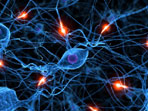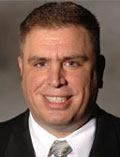 Reflex
sympathetic dystrophy (RSD) is a complex form of neuropathic pain
(pain from nerves). It is also known as complex regional pain
syndrome (CRPS). This syndrome is characterized by increased
sensitivity to normal stimuli, vascular instability, inflammatory
changes, emotional responses. RSD typically involves an extremity
(an arm or a leg). It is thought to occur because of the over
sensitization of sensory nerves and receptors. This leads to changes
in other structures including the sympathetic nervous system and
spinal cord, as well as the limbic system in the brain.
Reflex
sympathetic dystrophy (RSD) is a complex form of neuropathic pain
(pain from nerves). It is also known as complex regional pain
syndrome (CRPS). This syndrome is characterized by increased
sensitivity to normal stimuli, vascular instability, inflammatory
changes, emotional responses. RSD typically involves an extremity
(an arm or a leg). It is thought to occur because of the over
sensitization of sensory nerves and receptors. This leads to changes
in other structures including the sympathetic nervous system and
spinal cord, as well as the limbic system in the brain.
What are some of the causes of RSD?
RSD is usually preceded by some sort of minor trauma. Traumatic
events such as repetitive stress injuries, joint sprains, surgery,
crush injuries and fractures. In some cases, no traumatic event can
be identified.
Symptoms
Pain is typically described by patients as being intensely burning
and regional pain. The extremity is more sensitive to painful
stimuli as well as non-painful stimuli. Patients often report that
putting a glove or stocking on an affected extremity will induce an
excessive amount of pain as compared to a non-affected extremity.
Patients will typically avoid gloves, cold weather and windy
conditions because of this phenomenon. Patients may also have other
sensations such as numbness and tingling.
Clinical signs and symptoms of RSD
The clinical course of RSD is usually divided into four phases:
1) In the first phase, patients usually complain of increased
sensitivity to light touch, increased sensitivity to painful
stimuli, muscle weakness, muscle spasms, temperature changes,
sweating.
2) The second phase can include features of the first phase with the
addition of symptoms such as swelling, loss of hair, nail bed
changes, skin changes.
3) The third stage is characterized by muscle wasting, ulcers, rash,
increased color changes due to vascular instability.
4) The fourth stage is characterized by increased swelling, blood
pressure changes, autonomic nervous system changes.
Conditions such as diabetic neuropathy, vascular disease, peripheral
neuropathies, nutritional neuropathies, thoracic outlet syndrome,
carpal tunnel syndrome, other compressive neuropathies, disc
herniations, radiculopathy, myofascial pain syndrome and
fibromyalgia present similarly to RSD.
Diagnosis
To date, there is not one gold standard test that can diagnose RSD.
A careful history and physical examination is needed to help rule
out other conditions as mentioned above. Additional diagnostic
testing to rule out these other conditions may also include EMG/NCV,
laboratory evaluation, and radiographic imaging such as MRI or CT
scans. Tests that help to rule in the diagnosis of RSD include three
phase bone scan, diagnostic nerve blocks, quantitative sensory
testing and infrared thermal imaging. It is important to remember
that this condition varies among patients. Not every patient will
have a positive test or exhibit all of the clinical signs and
symptoms.
Treatment
Treatment
is tailored to the patient and the severity of the patient's
condition. In some cases, when treated early, RSD can respond to a
series of diagnostic/therapeutic nerve blocks. When the condition
has progressed, a multidisciplinary approach may be required. It is
important to understand that for all stages adequate pain relief is
required as well as mobilization of the involved extremity.
Specific Treatments for RSD
1) Physical Therapy. Physical Therapy is key at all stages for
patients with RSD. It is important for patients to mobilize the
affected extremity to help reduce long-term changes such as muscle
weakness and decreased blood flow.
2) Pain relief is also a top priority for patients. Medical
management, nerve blocks, electrical stimulation techniques (TENS
unit), acupuncture and spinal cord stimulation are examples of
commonly used modalities. Medical management will typically include
low dose antidepressants, nonsteroidal anti-inflammatory
medications, anti-convulsants and alpha blockers. Narcotic medical
management is only indicated in select cases.
3) Because RSD can be a very debilitating condition, patients will
often experience depression and other emotional disturbances.
Psychological and psychiatric evaluation in treatment is necessary
for patients who exhibit depressive and emotional disturbances or
who have had the condition for a long period of time without
improvement. Stress management techniques such as pacing, hypnosis,
relaxation and cognitive and behavioral therapy can be very useful
in helping patients to better deal with their pain. In addition,
patients being considered for narcotic management should also
receive psychological evaluation.
For more information on non-surgical and surgical treatment options
for treating reflex sympathetic dystrophy and to view informative videos,
please click here:
Animated Educational Videos.
Last revised: September 9, 2008
by Kostandinos Tsoulfas, MD


 Reflex
sympathetic dystrophy (RSD) is a complex form of neuropathic pain
(pain from nerves). It is also known as complex regional pain
syndrome (CRPS). This syndrome is characterized by increased
sensitivity to normal stimuli, vascular instability, inflammatory
changes, emotional responses. RSD typically involves an extremity
(an arm or a leg). It is thought to occur because of the over
sensitization of sensory nerves and receptors. This leads to changes
in other structures including the sympathetic nervous system and
spinal cord, as well as the limbic system in the brain.
Reflex
sympathetic dystrophy (RSD) is a complex form of neuropathic pain
(pain from nerves). It is also known as complex regional pain
syndrome (CRPS). This syndrome is characterized by increased
sensitivity to normal stimuli, vascular instability, inflammatory
changes, emotional responses. RSD typically involves an extremity
(an arm or a leg). It is thought to occur because of the over
sensitization of sensory nerves and receptors. This leads to changes
in other structures including the sympathetic nervous system and
spinal cord, as well as the limbic system in the brain. 



